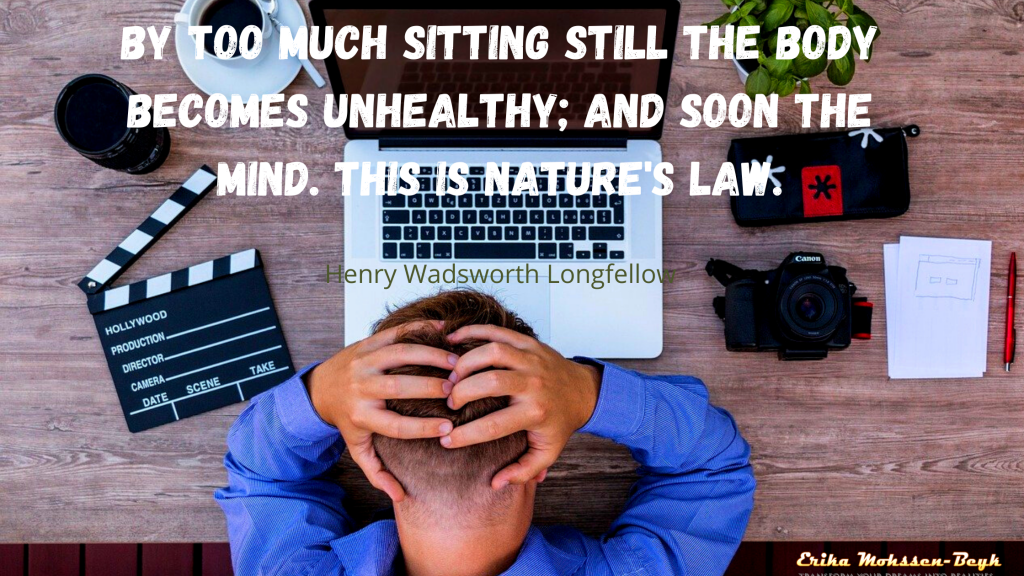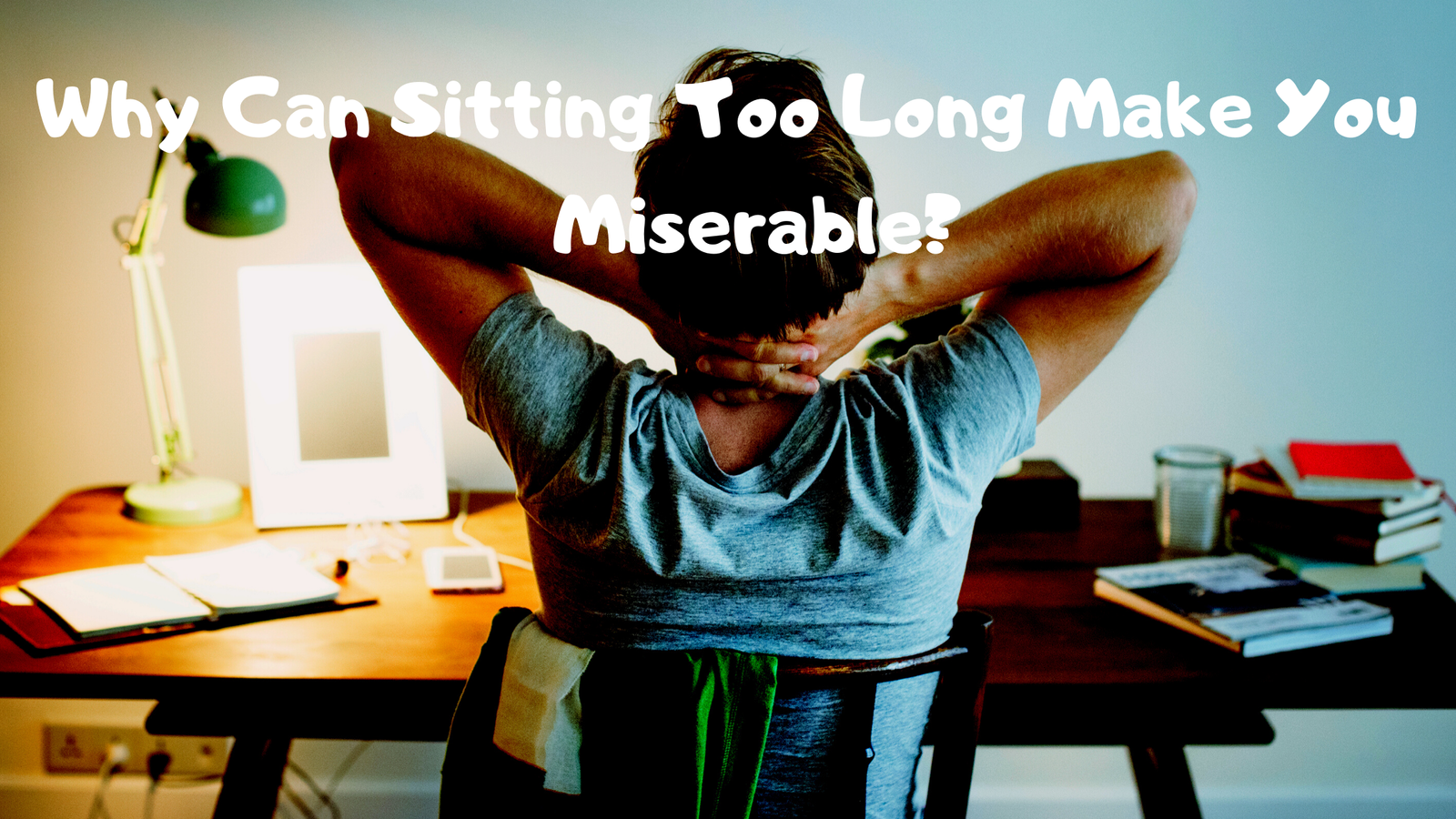Sitting too long kills, we hear often, but why?
Everybody knows that sitting too long time makes us sick. But not many stand up and do something about it. Are you one of these?
Prolonged sitting can make you sick and even depressed. Especially in our crisis time right now, there is a lot of anxiety and depression. Many are affected because of the lockdown and too long sitting, and the winter is coming as well.
I wanted to write about it because I know there are easy ways to avoid all this misery. And it does not even take much of your time.
I practice for a long time exercise and have no health issues at all. I sometimes sit too long, as well, but regularly do at least 30 minutes of meditation and exercise that activates the vagus nerve and keeps me healthy and happy. Seldom I miss my at least 30-minute walk, maybe by extreme weather.
Many people want to pay attention to their health.
At work, they have a green smoothie on the desk, a fitness bracelet on the wrist. The young generation drinks less alcohol for the sake of productivity. Even better for your health than a dose of vitamins is to get up from your desk regularly. Especially the ones who work in front of a screen need to get up and have movement regularly.
People in occupations with many movements, for example, are less likely to suffer from cardiovascular disease than people in sitting jobs.
A pity that there are more and more desk jobs. Every second working person spends his working day in front of the computer.

From Homo sapiens to Homo sedans
And after work, we continue sitting: Currently, adults spend more than half of their time on chairs, sofas, and armchairs. Most people sit on average 9.3 hours a day but sleep only 7.7 hours.
And these are only average values. If they drive to work by car, bus, or train, sit in the office for twelve hours and then hang around in front of the TV at home, it can quickly get up to 15 hours or more.
The problem is that the human body is built for walking and running, our ancestors’ principal activities. They were always up and about to hunt, gather fruit, feed the livestock, and work in the fields. It took two million years for the human species, Homo sapiens, to reach its present state of development.
However, the homo sedans, the sedentary people, only since the industrial revolution and the invention of new means of transport. The modern way of life could not adjust our organism in this short period of time.
Backache and headache are no coincidence: Persistent lousy posture because of prolonged sitting in front of the computer at work, or increased stress can cause painful tension in the back and neck muscles.
If dizziness and headache occur together, the cause may be a circulatory disorder in the cervical spine. The first cervical vertebra (atlas) is located directly in the neck below the brain’s areas that control the heartbeat, breathing rate, or swallowing. A minimal shift in this vortex is enough to affect the blood supply to the brain.
The tenth cranial nerve (Vagus nerve) is mainly affected by an atlas malposition. It can be so irritated that dizziness, headaches, or migraines are triggered.
Pills against pain do not work here; they only give relief for a short time.
If one considers this and that the vascular functions also decrease after just one hour of sitting, it becomes clear why permanent sitting is terrible for health.
Maybe knowing this gets some up and moving, breathing? Even walks can compensate for long periods of sitting.
Can sitting make you depressed?
The body can influence our thoughts, and the brain reacts even to positive facial expressions. The body can influence our thinking.
Our sitting posture also affects our internal constitution—people who sit many hours in front of the screen experience it often. Pain and tension are the physical effects of a hunched back. Even sitting upright in stressful situations can help avoid stress, think positively, and strengthen one’s self-esteem.
Walking is the medicine of the 21st millennium.
Walking is an amazingly effective medicine for the body and mind. It is the most natural way of getting around. With no other movement, the entire body is used evenly and healthily without overloading individual limbs or organs. It activates the organism, and the oxygen supply increases.
Also, our spine benefits from a walk. Every step acts as a massage on the intervertebral discs. Besides this, the activity makes the surrounding muscles more potent and gives the vertebrae a better hold.
Walking keeps active, more alert, and has a positive effect on the mood. Especially walking or hiking in nature is beneficial for the body and mind.
Relaxation is the art of resting before you get tired.
Everyone knows this: if you sit too long, you get tense at some point. The neck becomes stiff, and the shoulders ache, the legs numb. If you don’t do anything now, you’ll only tense up even more. The circulation continues to sag, and the oxygen supply is not optimal. Time for a few relaxation exercises: They help to prevent further tension and typical illnesses. Use them regularly before the neck becomes stiff.
Breathing exercise
In the case of stress: take a deep breath first! You know the tip. However, there is more to this than a mere phrase. Yogis have known it for a long time; breathwork can deliver powerful mind and body benefits. Pranayama is the fourth of Patanjali’s eight limbs of yoga. Breathing has a more significant impact on our health than many realize.
Controlled breathing is one of the simplest and most effective ways to relieve stress, relax, and encourage creativity. You can use it to stimulate the vagus nerve, among other things. It is the largest nerve of the parasympathetic and regulates the activity of almost all internal organs. Simultaneously, it releases neurotransmitters, which help us concentrate or relax.
A classic breathing exercise against stress is the so-called 4-6-8 method: sit or stand up straight, your shoulders straight, place your hand on your stomach and try to breathe there only through your nose – if possible, without that, the chest rises.
Breathe in slowly and deeply, count to four,
hold your breath count to six
Breathe out slowly through your mouth and count to eight.
Repeat the whole thing at least five times. With this exercise, you can breathe away stress as well as frustration or anger.
Suriya Namaskar – the sun salutation
Suriya Namaskar is a classic yoga exercise, and you can also easily integrate the relaxation exercise into everyday life – after the lunch break and in the afternoon, for example.
You can watch and imitate the yoga sun salutation for beginners here in the short video. And it can even be fun as you see here.
Another easy exercise everyone can do to activate the vagus nerve is the cat-cow exercise. Yoga exercises are good for the body, mind, and spirit. You do not have to twist your body like a noodle. It is much easier.
An Office workshop that everybody is able to do. Have fun!
See also > STRESS – IS MEDITATION A KEY TO STRESS MANAGEMENT?
And Why Investments In Your Well-being Bring The Best Interest
Why the investment in yourself becomes your most valuable asset
Click here: Download your FREE Copy of the Zen12 Brainwave Meditation Program HERE
Also, read > 2 Often Overlooked Energizers
What about you? Are you sitting too long?
Take 30 minutes out of your day and do some of these exercises. Make it a habit. You and your well-being are worth it!
Download my free e-book > Let The Sunshine In Change your thoughts brighten your Day and feel good about yourself Affirmations and insights to think about and learn to change our thoughts and perception which can change our life. May it help you to have a more positive outlook 🙂










great article
Thank you for sharing
Tractorgyan
Nice Blog, Long sitting is always harmful so if your sitting work then yoga is perfect medicine for it.
For someone like me who sits all day long slouched in front of the computer, this is a must read and implement thing.
It was at the back of my mind but this article made things clear and gave me exact steps that I need to start taking.
Thank you for providing powerful insights to improve various aspects of life through your blog.
Good, you found exact steps and hopefully start to do, my friend 🙂
It is not a lot of time needed, but if we make it a habit to move and stretch our body, it helps keep body, mind, and spirit in shape.
Get started. Thank you
Erika
Erika Mohssen-Beyk recently posted…Do You Treat Your Mind Like a Mansion or a Dump
Thank you for your post. This is excellent information. It is amazing and wonderful to visit your site.
It really gives me an insight on this topic.
I am glad the post did give you insights. Good to act on it for the better health.
Thanks for your comment
Erika
Yeah in lockdown people just doing work from and because of that they have to sit at home for too long so I think this blog will help those people who sit for long
Yes, and not only in lockdown, but most people also sit too long, and it is good to do something to stay healthy.
Thank you
Erika
Thanks for such a great post. You are right, siting for a ling time is not good for heath, it can hurt you badly especially in old age. You have mentioned the nice ways to get rid of that problem. Thanks again!
Right, sitting for a long time can make sick, it is good to do something, take breaks and exercise.
I hope you can use the ways mentioned to keep yourself fit.
Thank you
Erika
Hi Erika,
This article is completely informative and thanks for sharing this post. Your content is amazing.
Keep Posting!
Junaid, I am glad you found this post informative.
Thank you for your visit and comment
Erika
I always try to stand and do some stretches. It really helps
Although I am very new to the discipline of yoga, I have felt many benefits in my health, knowing and feeling my body in each session I do at home, guiding me with your videos. I have practiced yoga for beginners and flexibility. It costs a little but I know I will achieve what I want. Thank you for your articles and advice, they are very useful for me.
I am glad you liked the article 🙂
Keep doing yoga and get flexible.
Thank you
Erika
wonderful your yoga exercise experience